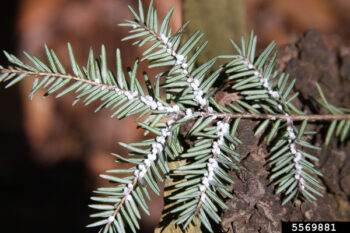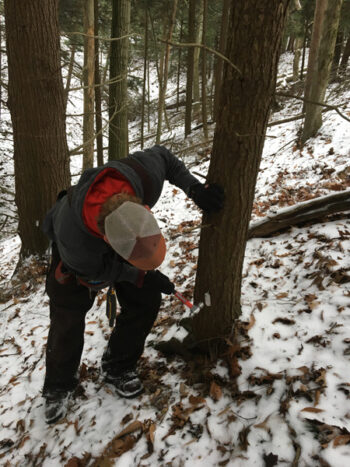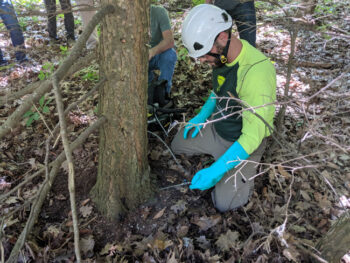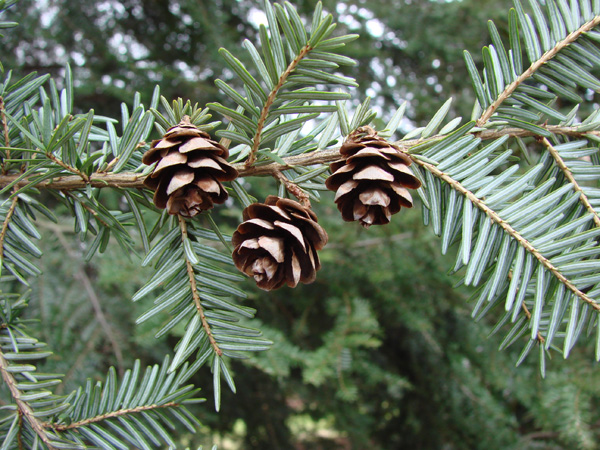REGION – The Michigan departments of Natural Resources and Agriculture and Rural Development encourage those who have eastern hemlock trees on their property to take time this winter to inspect the trees for signs of hemlock woolly adelgid. Anyone taking to the woods also can help by looking for signs of this invasive insect while hunting, hiking or enjoying other outdoor activities.
Winter is the best time to look for evidence of an infestation, according to Robert Miller, MDARD’s invasive species prevention and response specialist.

“Cooler temperatures trigger feeding activity,” Miller said. “As hemlock woolly adelgids feed, they secrete a white, waxy material that creates ovisacs. The presence of these small, round, white masses makes it possible to identify infested trees.”
As they feed, these tiny, soft-bodied insects consume a hemlock’s stored nutrients, slowly sucking the life from the tree.
These insects are considered invasive because they are not native to the state and can cause significant harm to Michigan’s estimated 170 million hemlock trees.
Infestations of hemlock woolly adelgid have been confirmed in Allegan, Ottawa, Muskegon, Oceana and Mason counties, all bordering Lake Michigan.
Winter surveys underway

Throughout the winter, survey crews from several cooperative invasive species management areas will look for signs of hemlock woolly adelgid, conducting surveys within a 5-mile border along the Lake Michigan shoreline.
Because hemlock trees can be protected from these insects with proper insecticide treatments, infested trees and any other hemlocks within the area will be mapped and tagged, then prioritized for summer treatment.
CISMAs will seek landowner permission to conduct surveys of hemlocks on private lands within the shoreline border. CISMA survey efforts, supported by funds from the Michigan Invasive Species Grant Program and the U.S. Forest Service, are provided at no cost to landowners.
Identify hemlock trees
Since adelgids feed and form ovisacs only on eastern hemlock trees in Michigan, it is important to distinguish hemlocks from other conifers like pines or spruces. Look for:
- Cone- or egg-shaped trees up to 75 feet tall.
- Drooping or feathery branches.
- Flat needles growing individually from the sides of twigs.
- Needles that are dark green on top with two parallel, white stripes underneath.
- Papery cones about three-quarters of an inch long that hang downward from branches.
Look for signs
Late fall through early spring is the best time to check hemlock trees. Look on the undersides of branches for evidence of round, white ovisacs near the base of the needles.
Up close, ovisacs look like tiny cotton balls and may appear alone or in clusters. The short video “Hemlock woolly adelgid: invasive species in Michigan” provides helpful identification tips.

Report your findings
Report infested hemlock trees by using the Midwest Invasive Species Information Network, available online at MISIN.MSU.edu or as a downloadable smartphone app. The MISIN smartphone app will take a GPS location point if a report is made at the site; it also will allow you to upload photos with a report.
Reports also can be made by email to MDA-Info@Michigan.gov or by phone to MDARD’s Customer Service Center at 800-292-3939.
Identify the location of infested trees and, whenever possible, take one or two pictures of infested branches to help confirm identification. To avoid spreading the insect, do not collect sample branches or twigs.
Manage your trees
If you find hemlock woolly adelgid on your property, it is important to know that certain insecticides are successful in treating the infestation if used correctly.
Without treatment, infested trees can die within four to 10 years. A qualified arborist, such as one certified by theInternational Society of Arboriculture, can diagnose and assist with treating infested trees.
If you are able to handle treatment on your own, follow the guidance provided in the MSU Extension bulletin “How to treat hemlock trees for hemlock woolly adelgid.”
Reporting infested trees, even if you will be managing them on your own, is important to help determine how far hemlock woolly adelgid has spread. This information also indicates where additional surveys may be needed.
Find more information
For more information on identification, reporting or treatment, visit the Michigan Invasive Species Program’s hemlock woolly adelgid page at Michigan.gov/HWA.
To find out more about the effort to inventory and treat infested hemlock trees in Michigan, view a recording of the January 2021 NotMISpecies webinar, “Hemlock Rescue,” available at Michigan.gov/EGLE/Outreach/Not-MI-Species-Webinar-Series.


